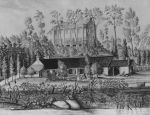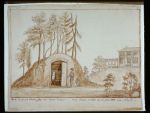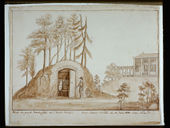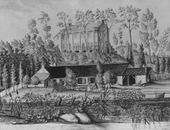Anne-Marguerite Hyde de Neuville
Anne-Marguerite-Henriette Rouillé de Marigny Hyde de Neuville (1771?— September 14, 1849) was an amateur French watercolorist best known for her sketches of the people and scenery she encountered while living and traveling along the northeastern seaboard of the United States during the first decades of the nineteenth century. Her carefully recorded observations are virtually unique during this period and provide invaluable historical and ethnological information. [1]
Born into an aristocratic French family, she fled Paris at the outbreak of the French Revolution and in 1794 married Jean-Guillaume Hyde de Neuville (1776-1857), an ardent royalist and political activist. Exiled from France by Napoleon Bonaparte in 1803, the couple spent several nomadic years in Europe before sailing to New York in 1807 with a letter of introduction to Thomas Jefferson. [2] Hyde de Neuville’s delicate pencil and watercolor sketches and her husband’s journal entries record their observations while voyaging up the Hudson River to Niagara Falls and on subsequent trips to Connecticut and New Jersey.[3] Whereas her husband commented frequently on the spectacular natural scenery, her drawings focused on the transformation of the American wilderness into a domesticated environment through the development of towns and country estates. She sketched the homes of several of her friends (many of them also French émigrés), including General Jean Victor Marie Moreau [Fig. 1] and the industrialist and amateur botanist Éleuthère Irénée du Pont [Fig. 2]. She made botanical studies of plants encountered on her travels, carefully recording, for example, a pale purple flower spotted on the banks of the Brandywine River during a visit to DuPont’s house and powder mill on September 6, 1810 (New York Historical Society).
After purchasing land on the Genessee River in New York State, the Hyde de Neuvilles established a farm called La Bergerie (“The Sheep Farm”). They spent winters in New York City, where they founded the École Économique, a school for French refugee children. [4] In 1811 the couple purchased land outside New Brunswick, New Jersey. There, they built a house and—in emulation of DuPont—raised Merino sheep, a type recently introduced to America, whose extremely fine fleece had launched a “Merino craze.” [5]
Following the abdication of Napoleon in 1814, Hyde de Neuville resettled briefly in France but she returned to America from 1816 to 1822 while her husband (who was created a baron in 1820) served as French ambassador to the United States. [6] From 1821 until 1823, Hyde de Neuville and her husband were the first in a long line of diplomats and statesmen to rent the Stephen Decatur House, the earliest private residence built in the immediate area of the White House. [7] Several of her pencil and watercolor sketches document the development of the neighborhood, then known as “President’s Square” (now Lafayette Square), as one of the most fashionable and socially prominent areas of the capital city [Fig. 3].
Although her many social and diplomatic engagements led to a decline in the volume of sketches, Hyde de Neuville continued to document highlights of her American experience. These ranged from an unusual flower specimen presented to her in 1816 by the Portuguese botanist and friend of Jefferson, José Correia da Serra (1750-1823) (New York Historical Society), to a drawing of the original family burial vault of George Washington at Mount Vernon, which had become a national shrine in the decades that preceded monuments to the deceased president in Baltimore and Washington Fig. 4]. [8] Hyde de Neuville’s husband shared her interest in documenting aspects of the New World. In 1816, he commissioned a number of French naturalists-- Jacques Gérard Milbert (1766-1840), Charles Alexandre Lesueur, and two graduates of the École Économique, Philippe (1800-1899) and Alexandre (1798-1876) Ricord—to collect specimens of indigenous American botanical and zoological specimens for the Museum of Natural History in Paris. [9]
--Robyn Asleson
Sites
F Street, Forest House, Greenwich Street, Moreau House, Mount Vernon, White House
Terms
Arcade, Arch, Avenue, Drive, Fence, Gate/Gateway, Lawn, Piazza/Veranda/Porch/Portico, Pot, Seat, Square, Statue, Vase/Urn, Walk, Wall, Yard
Images
Notes
- ↑ Françoise Watel, Jean-Guillaume Hyde de Neuville (1776-1857): Conspirateur et Diplomate (Paris : Peter Lang, 1997), 87-88.view on Zotero; John N. Burstyn, Past and Promise: Lives of New Jersey Women (Syracuse, NY: Syracuse University Press, 1996), 73-74. view on Zotero; Jadviga M. Da Costa Nunes, Baroness Hyde de Neuville: Sketches of America, 1807-1822 (New Brunswick, NJ: The Jane Voorhees Zimmerli Art Museum, Rutgers, The State University of New Jersey and the New York Historical Society, 1984), 3, 9-10 and passim. view on Zotero; William C. Sturtevant, “Patagonian Giants and Baroness Hyde de Neuville’s Iroquois Drawings,” Ethnohistory 27, no. 4 (Special Iroquois Issue) (1980): 338-43. view on Zotero
- ↑ J. Jefferson Looney, ed. The Papers of Thomas Jefferson 40+ vols. (Princeton: Princeton University Press, 2008), 5: 408. view on Zotero; Watel, 1997, 5-39. view on Zotero;da Costa Nunes, 1984, 1-3. view on Zotero
- ↑ Gloria Gilda Deák, Passage to America: Celebrated European Visitors in Search of the American Adventure (London and New York: I. B. Tauris, 2013), 1-5. view on Zotero; Jean Guillaume Hyde de Neuville, Mémoires et Souvenirs Du Baron Hyde de Neuville, ed. Pauline Henriette Hyde de Neuville Berdonnet, 3 vols. (Paris: E. Plon, Nourrit et cie., 1892, 2nd ed.), 1: 452-61. view on Zotero
- ↑ Deák, 2013, 5-11. view on Zotero; Watel, 1997, 71-73.view on Zotero
- ↑ Deák, 2013, 13. view on Zotero; Watel, 1997, 51-52.view on Zotero; Burstyn, 1996, 73. view on Zotero; da Costa Nunes, 1984, 14. view on Zotero
- ↑ Deak, 2013, 15. view on Zotero
- ↑ Joel D. Treese, “Baron and Baroness Hyde de Neuville and Decatur House.” The White House Historical Association, June 19, 2014. view on Zotero; Robin Fogg Schuldt, “Decatur House: A Home of the Rich and Powerful.” Organization of American Historians Magazine of History 14, no. 2 (Winter 2000): 51.
- ↑ da Costa Nunes, 1984, 29. view on Zotero
- ↑ Harry Liebersohn, Aristocratic Encounters: European Travelers and North American Indians (Cambridge: Cambridge University Press, 2001), 83. view on Zotero; Charles Edmond Monod, Éloges et Notices Lus À La Société de Chirurgie (Paris: G. Masson, 1895), 3-5. view on Zotero








